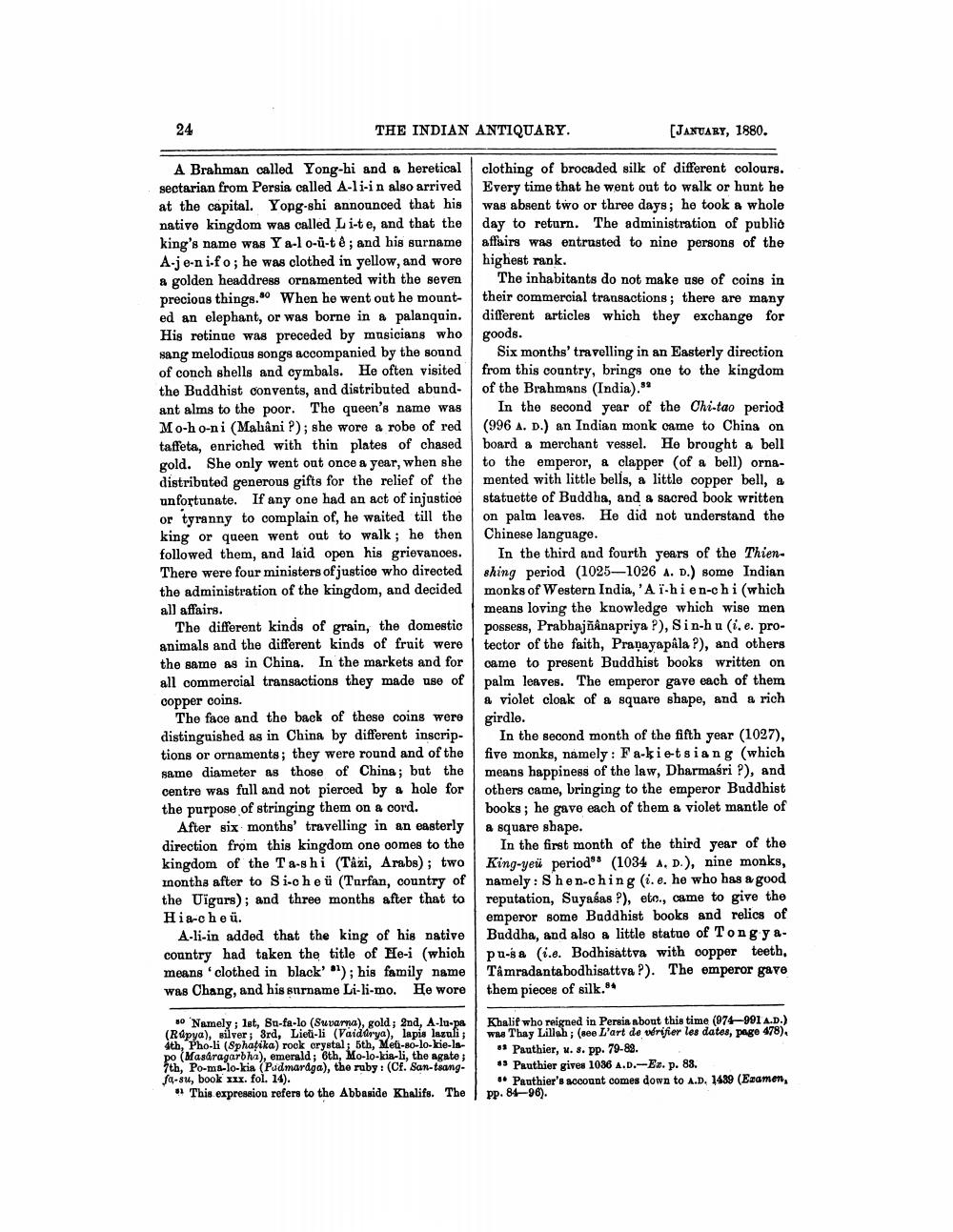________________
24
THE INDIAN ANTIQUARY.
(JANUARY, 1880.
A Brahman called Yong-hi and a heretical clothing of brocaded silk of different colours. sectarian from Persia called A-li-in also arrived Every time that he went out to walk or hunt he at the capital. Yong-shi announced that his was absent two or three days; he took a whole native kingdom was called Lite, and that the day to return. The administration of public king's name was Y a-l o-u-t ê; and his surname affairs was entrusted to nine persons of the A-je-ni-fo; he was clothed in yellow, and wore highest rank. & golden headdress ornamented with the seven The inhabitants do not make use of coins in precious things. When he went out he mount- their commercial transactions; there are many ed an elephant, or was borne in a palanquin. different articles which they exchange for His retinue was preceded by musicians who goods. sang melodious songs accompanied by the sound | Six months' travelling in an Easterly direction of conch shells and cymbals. He often visited from this country, brings one to the kingdom the Buddhist convents, and distributed abund- of the Brahmans (India)." ant alms to the poor. The queen's name was In the second year of the Chi-tao period Mo-ho-ni (Mabâni ?); she wore a robe of red (996 A. D.) an Indian monk came to China on taffeta, enriched with thin plates of chased board a merchant vessel. He brought a bell gold. She only went out once a year, when she to the emperor, a clapper (of a bell) ornadistributed generous gifts for the relief of the mented with little bells, a little copper bell, a unfortunate. If any one had an act of injustice statuette of Buddha, and a sacred book written or tyranny to complain of, he waited till the on palm leaves. He did not understand the king or queen went out to walk; he then Chinese language. followed them, and laid open his grievances. In the third and fourth years of the ThienThere were four ministers of justice who directed shing period (1025-1026 A. D.) some Indian the administration of the kingdom, and decided monks of Western India, 'Ai-hien-chi(which all affairs.
means loving the knowledge which wise men The different kinds of grain, the domestic possess, Prabhajñanapriya ?), Sin-h u (i.e. proanimals and the different kinds of fruit were tector of the faith, Pranayapala P), and others the same as in China. In the markets and for | came to present Buddhist books written on all commercial transactions they made use of palm leaves. The emperor gave each of them copper coins.
& violet cloak of a square shape, and a rich The face and the back of these coins were girdle. distinguished as in China by different inscrip- In the second month of the fifth year (1027), tions or ornaments; they were round and of the five monks, namely: Fa-kie-tsiang (which same diameter as those of China; but the means happiness of the law, Dharmasri ?), and centre was full and not pierced by a hole for others came, bringing to the emperor Buddhist the purpose of stringing them on a cord.
books; he gave each of them a violet mantle of After six months' travelling in an easterly
a square shape. direction from this kingdom one comes to the In the first month of the third year of the kingdom of the Ta-shi (Tazi, Arabs); two King-yeü periodo (1034 A.D.), nine monks, inontha after to Si-che ü (Tarfan, country of namely: Shen-ching (i.e. he who has a good the Uigurs); and three months after that to reputation, Suyabas P), etc., came to give the Hia-cheü.
emperor some Baddhist books and relics of A-li-in added that the king of his native Buddha, and also a little statue of Tong y acountry had taken the title of He-i (which pu-ga (i.e. Bodhisattva with copper teeth, means clothed in black'); his family name | Tamradanta bodhisattva ?). The emperor gave was Chang, and his surname Li-li-mo. He wore them pieces of silk.*
Namely; Ist, Sa-fa-lo (Suvarna), gold; 2nd, A-lu-ps (Rupya), silver 3rd, Lieu-li (Vaidurya), lapis lazuli; 4th, Pho-li (Sphatika) rock crystal, 5th, Met-so-lo-kie-lspo (Masaragarbha), emerald ; 6th, Mo-lo-kia-li, the agate; 7th, Po-ms-lo-kis (Pudmardga), the ruby: (Cf. San-tangfa-su, book max. fol. 14).
This expression refers to the Abbaside Khalifs. The
Khalif who reigned in Persia about this time (974991 A.D.) was Thay Lilleh; (100 L'art de vérifier les dates, page 478).
** Pauthier, M. s. pp. 79-89. * Pauthier gives 1036 A.D.-Ed. p. 83.
** Pauthier's account comes down to A.D. 1489 (Ezamen, pp. 84-96).




